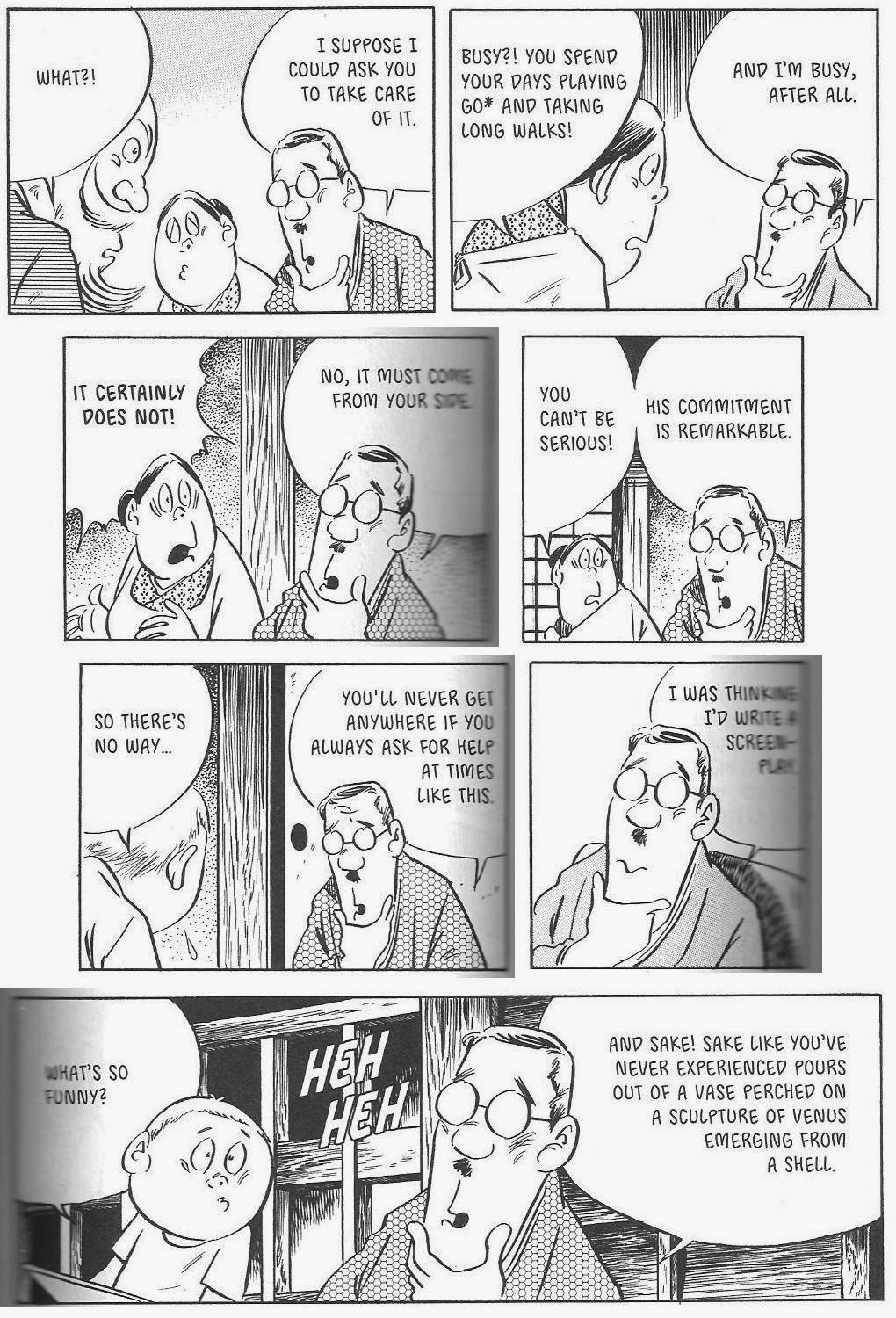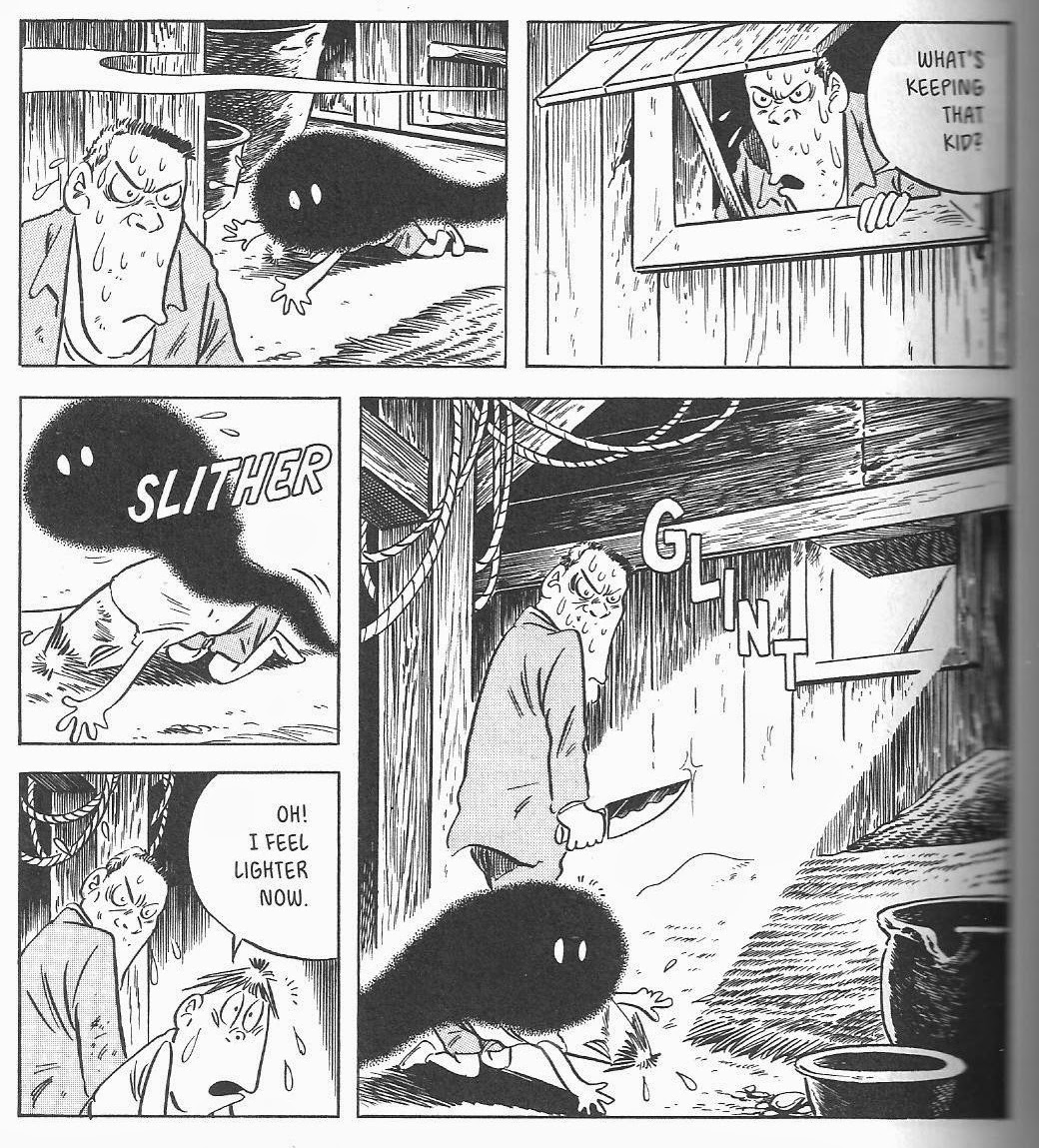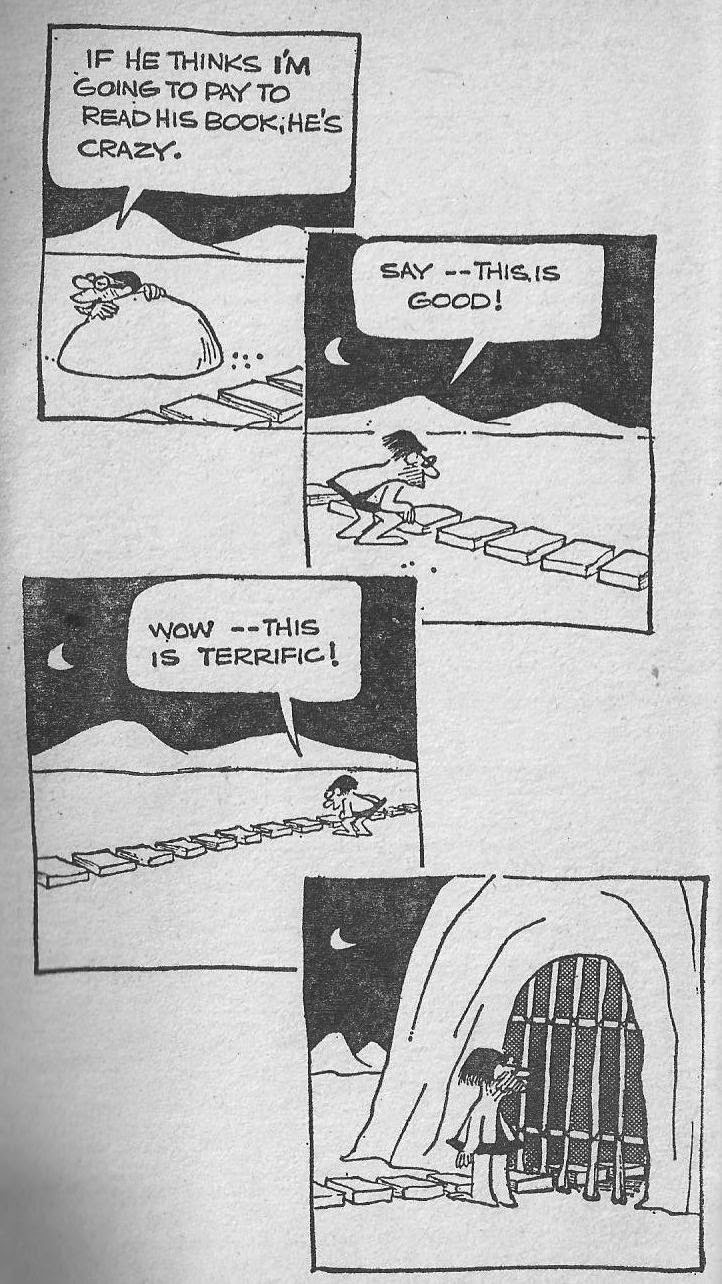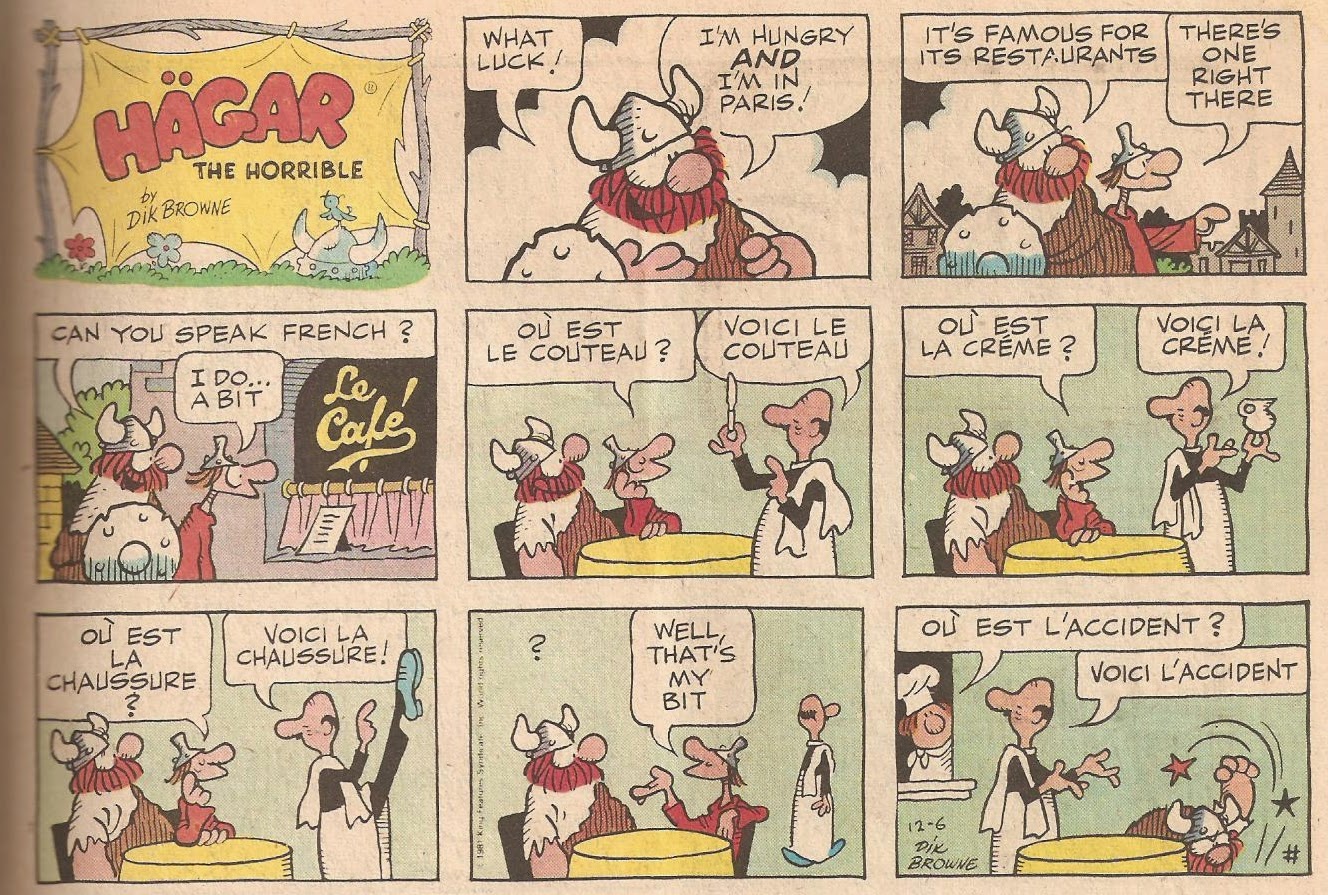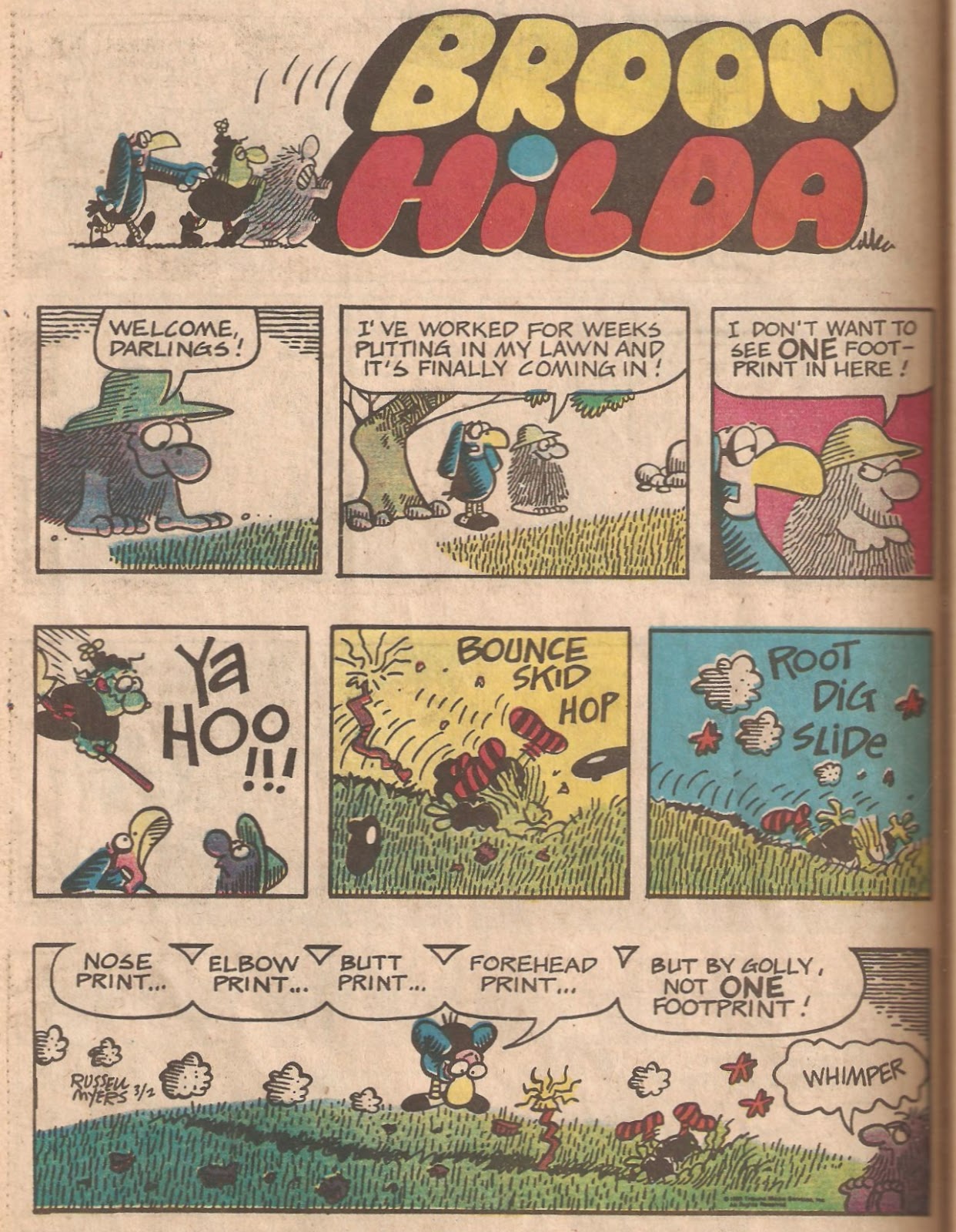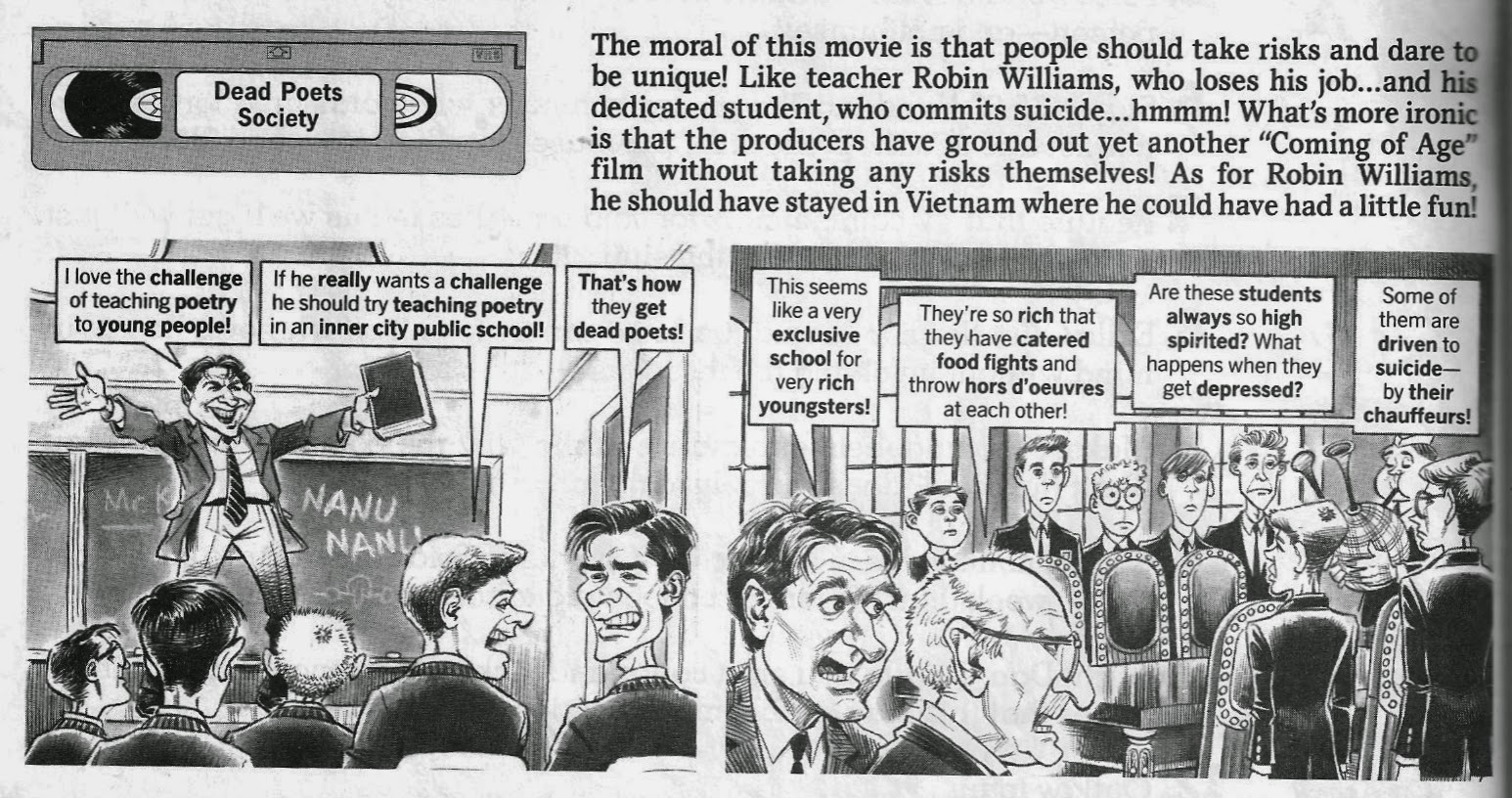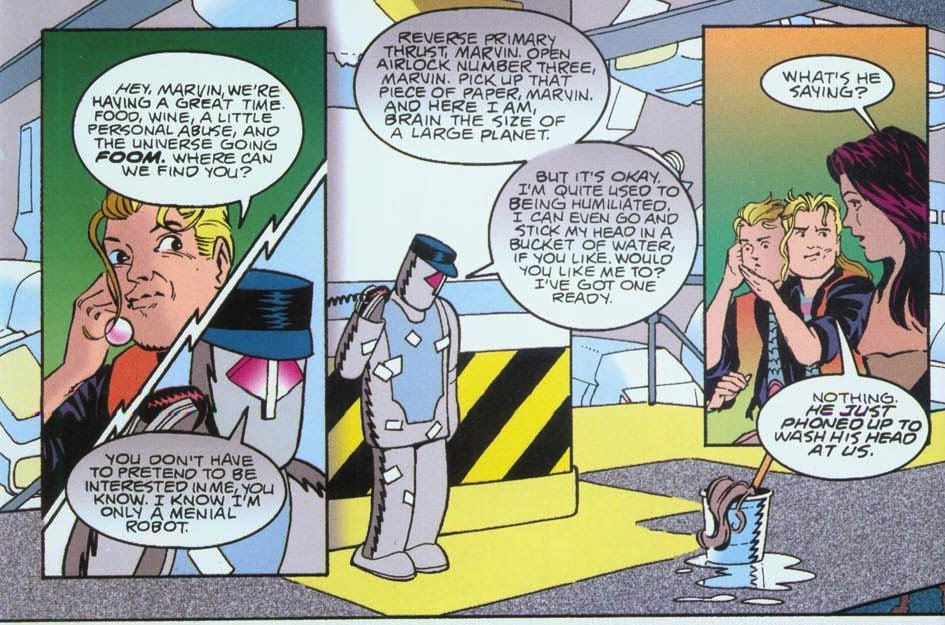Sometime late last year, I was approached by an Indian fan who wanted to interview me and Minifig for scanlating two Asterix tribute albums from various French artists. I was suspicious at first, since I'd heard of Nigerian princes asking for confidential information to access their bank accounts, but surely there must be an easier way to gain acceptance than through comic scans. I checked the man's credentials online, and was surprised to find out that his online essays were better written than his emails. Maybe he took greater pride of his outward presentation for the world to see than with online correspondence. I know some people like that.
I decided to test the waters, since I didn't have anything better to do, and if the questions veered into personal territory, I would know to back off. When I got back a set of questions, they seemed perfectly reasonable, and there was no possible way that any personal information could've been gleamed off those, save my personal opinions. Having vouched for the veritability of the questions, I went about trying to find my scanlation partner.
The only problem was, I hadn't heard from my co-partner, Minifig for over a year, and he hadn't made his presence known on the internet for quite some time. I felt bad about being the sole beneficiary of the interview, since I felt I should share the credit with someone who made the bulk effort of the scanlation process. (
Which I can tell you from personal experience is not as easy as it sounds) At the last minute, I got a reply from one of my sources, and sent the list of questions his way. After which, I was assigned to proofread an edited version of our questions to make it more palpable for Indian Comixology readers.
That was in mid-November, and I'd hoped to have it up in December so I could show the full questionaire in conjunction with one of my old
blog posts about reading lips being made available for a Deaf newsletter. (
Page 17) A month went by, then two. I contributed another
blog post about deafness in movies (
Page 13), and still nothing.
I asked the interviewer if he had any idea when our interview would be be shown, since I was becoming increasingly impatient as to when it would be shown. (
Even though I didn't sign a confidentiality agreement, I still felt I owed them that much) He reassured me, saying that he was sending multiple reminders to the Comixology editors daily, but still wasn't getting any response. Then, just last week, I got an apology email, saying that after a long delay, it looked like they weren't going to present our interview after all. If this was a Phishing expedition, it was certainly the most unusual one I've ever been exposed to.
With that longwinded background detail over, here's what would've been the interview:
Greetings from Trivandrum, comic lovers. This time around, I have a special guest- rather, the duo consisting of DanielBT and Minifig who colaborated to translate several European comics into English, including 2 Asterix albums.For those of you reeling in shock, the above is not a misprint - its not done by the usual team of Anthea Bell and Dereck Hockridge, and the two Asterix albums in question areASTERIX ET SES AMIS (Asterix and his Friends- a tribute to Uderzo)
and UDERZO CROQUÉ PAR SES AMIS (Uderzo as Seen by His Friends- a tribute to Uderzo),
Asterix parodies done in the signature style of famous European cartoonists.![]() Don’t bother looking for it on Amazon. These two albums haven't been officially translated to English by the Asterix Publishers. And many Asterix fans in this part of the world had to wait... and wait and wait to see whether this would ever be translated. The scenario looked bleak and that’s when Daniel and Minifig joined hands and decided to translate the two comics... and legions of Asterix lovers are thankful to the duo for their valiant efforts. I had the pleasure and privilege to Interview them, and this is what they had to say:
Don’t bother looking for it on Amazon. These two albums haven't been officially translated to English by the Asterix Publishers. And many Asterix fans in this part of the world had to wait... and wait and wait to see whether this would ever be translated. The scenario looked bleak and that’s when Daniel and Minifig joined hands and decided to translate the two comics... and legions of Asterix lovers are thankful to the duo for their valiant efforts. I had the pleasure and privilege to Interview them, and this is what they had to say:
From Asterix lovers all over India - a special thanks, thank you for translating to English ASTERIX ET SES AMIS and UDERZO CROQUÉ PAR SES AMIS.1. What prompted you take the job of translating European comics-as you put it “mighty translation of European comics”?Minifig: I was wandering around the convention floor of BICS (
British International Comics Show, a now-defunct – and greatly missed
- comic book convention) and I noticed a stand from a company called Cinebook. They had exceptionally good offers,which I soon took advantage of – 2 for 3, 1 Lucky Luke album, 1 Clifton and (
I think)1 Blake & Mortimer. Unlike most of my impulse convention purchases, I didn't regretit! Soon after, I started seeing a few scanlated Eurocomics being posted on messageboards I was frequenting, and those two things inspired me to learn more about this world of comics that I'd previously been blind to.
DanielBT: Well, I'd been downloading various English scanlations of random European comics that weren't available in Heavy Metal (
which as a gateway to European stuff, is mostly devoted to the serious stuff and offers easy wank material, but isn't always to my taste, and the few magazines I own are those I deem having enough quality content worth keeping) when I noticed that there was a surprisingly lack of variety in the choice of certain words, and a high rate of spelling mistakes. Not to mention the sentence structure was all kinds of wonky from doing nothing more than straight translations without double-checking to verify an alternate use of a word. Likewise, some French words would be left entirely untranslated, leaving a gaping hole in someone's sentence, and causing confusion to the reader. (
i.e. me) I was going
mad with these annoying gaffes, and would go about and edit them in the privacy of my home, when it occurred to me that I could simply cut straight to the middleman and bring my complaints to the translators themselves. Besides, the only one benefiting from my edits was me, and I wasn't sharing my results with anyone, so why should others suffer from easily preventable mistakes?
![]()
Most of these translations were being done by people whose first language wasn't English, so they were completely unaware of the kinds of mistakes that could've been easily preventable. Sometimes it was the usage of slang that would slip them up, and they would be unaware of an English equivalent. One example would be the 7th volume of Game Over: "
Only For Your Eyes", when it would sound better as "
For your Eyes Only". In some cases, it's a simple matter of rearranging words around so they'll sound better. In other cases, it's not knowing which proposition to use.
![]()
One thing that I'm sorry I didn't include in my blog post about
European translations was a tip to compare the translation of a well-known American property, such as
Maus or
V for Vendetta, or even
Calvin & Hobbes, and see how even the most colourful slangy sentence can be reduced to a rather static flow of repetitive words. For instance, lower-class swears such as "
Oh Bloody Hell", "
Goodness Sake", and "
Goddamn" can all be translated into French as "
Mon Dieu".
Once you begin to see how a quote can be pared down to the basic elements, you can reverse-engineer a commonly-said word into something that won't be limited to stock catchphrases. These words are fine when used in moderation, but when they're used all the time, it becomes somewhat tiring, and smacks of repetition. It's the difference between relying on a "
KYAA!" and an "
Eeek!" for a girlish scream. As the saying goes, "
If all you have is a hammer, everything looks like a nail".
Since I've pointed out these niggling details, I'm please to note that there's been an uptick of quality from various translators who I haven't personally proofread. It's somewhat amazing that I'm able to help out at all, since I have barely a basic knowledge of French, and all my personal translation projects comes from retyping the entire sentence on GoogleTranslate and trying to decipher their results in a coherent manner that makes sense.
![]() 2. How did you guys happen to meet?DanielBT
2. How did you guys happen to meet?DanielBT: Well, it was somewhat of a happy coincidence. I started out by pointing out various spelling mistakes on a blog that was translating the 2nd and 3rd albums of
Violine (
a girl with purple eyes who can read people's minds by looking in their eyes), and wanted to improve the quality of the text. Surprisingly enough, the translator was happy to receive my input, and I was able to help out to the album's completion. We hoped to continue with the remaining two books, but other side projects kept getting in the way, and the translator's been kinda busy with other stuff, and hasn't had much time after I've helped proofreading Fabrice Tarrin's
blog comics. I hope to get back to
Violine someday.
Anyways, from there, I offered my services to anyone who would be glad to accept my harsh criticism. Minifig showed up on a
plus4chan page that was full of
English translations projects, and when he mentioned that he was working on an Asterix book, but he hadn't heard back from a proofreader, I offered to lend my services in his direction, but was reluctant to give my contact information for the world to see, and suggested he log in on a comic forum I was acquainted with, and things expanded from there. He wasn't even
aware of a second Asterix parody/tribute book until I mentioned it.
![]() Minifig
Minifig: I'd already completed
Asterix et ses Amis when DanielBT offered his services; I'd been having trouble with one joke in particular that I couldn't figure out. I had been offered help with proofreading before, but the original volunteer never got back to me. He also introduced me to
Uderzo, which was a surprise to me - I thought I'd already dealt with Albert's old birthday presents well before his 90th birthday! However, I welcomed the challenge, as working to a deadline means you're a lot more productive.
3. How does the work process of translating the comics go?Well, Minifig did the main bulk of translating the comics while sending me a copy of the French original so I could check for punctuation and word usage. My aim in cleaning up the English version is to portray a version that comes as close to the original without betraying anything that could be lost, and choosing words that'll match the action on the page. The tricky part is finding words that'll fit in the balloons, and making sure space isn't too cramped, which can result in some creative rewriting to remain as faithful as possible. I also double-check to make sure that any dialogue isn't missing. I've had to deal with more than one blank balloon. You'd be surprised how often it comes up. I once had a page (
not Minifig's) that had ALL the dialogue blanked out, and I wondered if that was how it was supposed to appear. The correct version showed up in the next installment, but fortunately the damage was caught before it was released to the public. One could only imagine the amount of confusion that would've resulted otherwise.
I can't speak for how Minifig's translation process went, but from the notes from our correspondence, his philosophy was that in the instances where he deliberately skewed from the text on the page to implement his particular brand of humour (
which I objected to) since he was following the same model as
Ted Woolsey for creating silly sentences that skewed far from the source material, but didn't necessarily improve on the joke.
There was an instance where Minifig used the word "
pot" for one of the comics, but I suggested the proper use of "
cauldron", since it was the term used in the Asterix books, even if it meant scrunching up the dialogue on the page. One thing I would've liked when these corrections were being done was to have the same font used again. It might be undetectable to the casual reader, but these little inconsistencies really stick out in my craw. Of course, considering my method for finding a matching font is to type a typical sentence besides the original, then scroll through the entire list until I find a close match without bothering to take notes, so its perfectly understandable why Minifig didn't go the extra mile.
![]() |
| An unseen first draft of the page in question. |
Minifig: I translate on a panel-by-panel basis, using Google Translate for every sentence (
It's not a perfect tool, so sometimes I use Reverso for specific words). Next,I edit out all the original text, then I start typing in my translation. I generally use Google Translate as a rough guide; as I said, it's not a perfect translation tool, and I usually have to reword what I've been given into something an actual human being would say. Sometimes, I can translate a sentence purely by sight alone. I sometimes have to tweak things here and there, usually the font size. I use Paint.NET for editing images - I find it a nice halfway house between Photoshop's breadth and versatility and Microsoft Paint's utilitarian functionalism. When I'm done with a few pages, I send my work to DanielBT, who points me in the right direction. I tend to get a little self-indulgent, and he's very good at making me adhere more to the actual story, not how I wish the story to be.
![]()
4. I am curious about the username Minifig- tell us something about the man/woman behind this strange name?DanielBT: You'll have to ask him. It could be a short combination of Mini figurines, but until he shows up to clarify otherwise, we'll never know for sure.
Minifig: I'm afraid it's a rather dull story – I was getting into the Lego Star Wars games, which rekindled my love of all things Lego. I learnt that the little Lego people are called "
minifigures", or "
minifigs" for short. I thought it sounded nice, so I started using it for a username. And now you know the rest of the story!
5. Now, as I understand what you are attempting is independent translation of comics done purely out of passion for comic lovers. Do you ever wonder if the actual publishers may create trouble in any way?Minfig: It's not unheard of. I heard of some brouhaha with Shueisha and some Narutoscanlators a while back, and Disney removed some pages of a fan translation of
PKNA. However, I don't think that the majority of scanlators have too much to worry about, especially eurocomics scanlators – most of what we translate isn't going to get an official release any time soon.
Asterix et ses Amis was a perfect example of that - when I started reading it, I was thinking "
Why hasn't this gotten an official release?" and then when I saw the story where Donald Duck and Gyro Gearloose take Asterix and Obelix to Duckberg I thought "
Oh, that's why..." - an official release would be nice, but realistically it's too much of a legal nightmare to even contemplate.
![]() DanielBT
DanielBT: That's the basic question that's been plaguing the Manga industry, which has its own dilemma from having
TOO MANY titles available, often with similar plots, so its the ones with the most outrageous art and stories that stick out from the crowd that get the most attention. Mostly, it's the current long-running titles such as
Naruto,
Bleach and
One Piece that's had the highest number of interested fans wanting to see the newest installment which hasn't hurt their sales or popularity one iota. There's been talk about shutting down these sites down for ages, but as long as fans keep somehow finding early releases of these titles, one cease and desist order will just spring up a dozen imitators elsewhere.
Nowadays, its these properties that get widely pirated that get the highest interest rate among the audience even as Hollywood openly decries against such practices. The irony is that those movies and TV shows that are widely shared via bittorrent are those that are also the the most bought for personal use. You'd think that after having tasted a free sample, you'd be content with having gotten a story for free, but that hasn't been the case here. The audience having had a taste of a quality piece of merchandise feel more assured that they're getting something worth keeping and want something for posterity. whereas other properties that flounder about in obscurity shows the extent of audience interest in certain titles. That kind of data is extremely valuable to companies who want to know where their customer's tastes lie. The more used you become to certain artwork and stories, the more likely you're willing to spend money on them. I get the sense that European artists would
love to see their old work get wider distribution outside their country, which couldn't hurt their recognition factor.
![]()
It makes sense if you think about it - you're normally reluctant to try something new, even if your closest friends
praise it to the skies as do so many reviews of a stellar book, you get the feeling that they're trying to
sell you something that's basically "
TRY this new
dishwater! You'll
LOVE it!" Especially daunting are long
long long works that take awhile before they become worthy of the hype, which because of their slow buildup, can be something of an acquired taste. It also speaks that people are more likely to revist their favorite comics they read as a kid, so implanting these various kinds of comics early on can't help but broaden their horizons.
![]()
The difference between Manga and BD is fairly wide. Manga has hundreds of pages in black and white, but mostly large balloons, which gives you a feeling of accomplishment when you finish editing pages in a rapid manner. Whereas, BD have colour pages (which take longer to scan) and plenty of dialogue throughout and becomes something of an uphill struggle where you feel relieved just to finish one page, with more to go.
The closest comparison would be old-school Mangas with their numerous amount of talking panels per page. Given the amount of dedication and work needed to put out a quality work, I wouldn't be surprised if the burnout rate was fairly high.
I think what the real concern over is, is that people will grow more accustomed to stealing stuff online rather than actually purchasing the things themselves. Food produce manages to overcome this hurdle by giving out free samples of their fares, but I don't know how far that analogy comes when it comes to telling stories. Unless there's material that'll make more sense upon rereading, once you've got the general gist, there's not much point in going back and checking for clues.
![]()
6. How do you guys decide which work deserves to be translated?Minifig: It's either a random choice ("
Ooh, this looks cool!") or pure nostalgia ("
Hey, Johan & Peewit! I remember them from The Smurfs cartoon!"). I then ask around, to see if anybody plans on translating it, or if it's any good. If it's "
No" to the former and "
Yes" to the latter, then I get to work.
DanielBT: After we finished with the Asterix books, there was an online poll regarding which other projects people would be interested in us doing next. The turnout was rather disappointingly low, with votes for
Ric Hochet, one for
Johann & Peewit, and some redundant requests for
Clifton, even though
Cinebook was doing those. The whole purposoe of scanlations was to bring publicity to comic titles that might not be otherwise known. We wound up doing the first album of
Johan and Peewit, and two albums of
Michel Valiant, which wasn't entirely to my taste.
Some titles I wouldn't mind proofreading would include the remaining
SODA albums,
Spoon & White,
Pauvre Lampil,
Sentai School,
Pacush Blues, later albums of
Les Jungles Perdues, or pretty much anything that looks potentially interesting. Of course, I'd have to find someone willing to work with me for that. I contemplated doing the solo tribute to Lucky Luke,
Rocky Luke, but the amount of photoshopping of certain pages scared me off, (
I mainly use Paint) and I haven't made much progress since.
![]()
7. Now in India - European comics means Asterix and Tintin. There is a huge fan following for Goscinney-Uderzo and Herge. Now that Asterix has been finished, will you be now turning to the works of these two legends which have not yet been translated to English?? Haute Tension is the only work in the Quick and Flupke series not to have been translated to English; and Mr. Mops., Mr. Bellum, etc. still have not got English translation. Same with Goscinney /Uderzo’s other works like Luc Junior and Jehan Pistolet have not been yet translated to English. Would the “Mighty Translation” team take the wishes of Indian comic lovers in consideration?DanielBT: I had
no idea that there were English copies of Quick & Flupke in India, but since sales and knowledge of that series is so abysmally low here, they might as well not exist. There was a
fan attempt to translate some volumes as well as some comics that were left out, but I don't know how that panned out.
There would have to be some kind of outside demand for this kind of material. It's the catch-22 situation where there's worthy historical comics by cartoonists before they became famous, but they can't be made available if there isn't demand for them, and there won't be any demand until they become available. Its the factor of not knowing what the audience wants that they don't
even know what they want. Then there's the possibility of their old stuff not appealing to today's readers.
Dr. Slump was passed over here, because of its gag Manga format and overreliance on poop jokes. (
Even now, scanlations haven't progressed past the 6th volume) As for Herge and Uderzo's lesser-known works, I'm afraid I'm not knowledgeable enough about them to help out there. But if there are any aspiring translators willing to work on them, I'd be happy to lend a helping hand.
Minifig: The main problem is that Europe has an embarrassment of hidden riches, as far as the comics scene is concerned – there are many beloved series going back decades. I've already attached myself to a handful of these classics:
Johan & Pirlouit,
Professor Palmboom,
Ric Hochet,
Michel Vaillant... the problem with being a kid in a sweet shop is that if you try to eat everything you see, you'll make yourself sick.
![]()
Fortunately, there are more Eurocomic scanlators now than there were when I first started – I've occasionally come across somebody who knows some French, but doesn't know where to start, so I point them in the direction of older comics. There's also the question of available scans; Europeans are less comfortable with the idea of scanning their own comics, as they consider them to be works of art, or at least view them with more than a little nostalgia. We're very lucky that so many Europeans have decided to sacrifice their own collections so that we all can enjoy them. At the end of the day, the best way to get classics translated is to let publishers know that you want to see series like
Jehan Pistolet and
Quick & Flupke translated. The main reason a story isn't published is because the people in charge think the story won't sell. Raising awareness can be the best way to get what you want!
8. Have you ever thought of starting your own comic, or are you satisfied staying as unsung hero for scanlators?Minifig: I've toyed with a few ideas, but I've not been able to expand on them in any meaningful way. I think I might need to find more time to work on both scanlating and writing...
DanielBT: Oh, I've had all kinds of comic ideas just waiting to be jotted down. I've written several drafts that have yet to be completed. My desk is full of little pieces of paper of written notes taken from dreams and daydreams and anything that strikes my fancy that I've yet to organize in a coherent manner resembling a proper narrative. The problem basically stems from a lack of motivation from nobody to spur me on. Not to mention minor annoyances such as constant interruptions to schedule conflicts and not feeling like writing when I'm anxious. I basically have to be persuaded into writing, and apart from outside influences, I'm unlikely to finish a personal project anytime soon. I'm a terrible self-motivator without a deadline.
The main obstacle comes from finding an artist whose artwork I feel can properly convey the worlds I have in my head. I worry about my vision becoming squandered by the artist's limited ability to show the full range of my imagination, or me failing to take advantage to the artist's main strengths and wasting their time.
When there was the announcement of a program where you could virtually "
Make your own Manga", I was potentially excited, until I actually had a chance to use a sample of the program in question, and found it somewhat limiting. It was more suited for 4-panel comics, with stock character bodytypes in typical school settings, which limited the amount of subject material and variety somewhat. Even the wider Manga page was composed of straight borders, without allowing for crooked borders or even collage collapsible panels typical of Shoujo Mangas. Then there was the constant zooming in and out of their poses and the word balloons were oftentimes larger than I would've personally wanted, which was something of a pain. I understand there are people who are satisfied with this kind of thing, but it's simply not for me.
This is further hampered by only allowing a small portion of my writing to be seen among a select number of people I trust. And short of posting them on my blog or a site like
Fanfiction.net, they're unlikely to garner much attention unless I display a fair amount of publicity, and I'm loath to do much cross-promotional advertising. Besides, I'm forever constantly rewriting my work, and worry about releasing an inferior product to the world until I'm completely 100% satisfied. Considering my impossibly high bar of quality, and how nervous I am about showing my work to anyone, and the distraction of video games gobbling up my time, I worry that I may never get a chance to show my writings until I overcome these fears.
The majority of comics I've contributed to
Square Root of Minus Garfield is just the
barest fraction of the scope of my creativity. But that's basically taking the template of an already popular character and running with it as far as my imagination goes. I want to be able to explore concepts with characters of my own making.
9. Asterix and the Picts is coming our this month - with new artists and writers behind the creation. How do you see the future of Asterix without Goscinney and Uderzo?![]() Minfig
Minfig: When I read about the decision, I wasn't surprised. They've been trying to revitalize the Asterix franchise for years, with varying levels of success. Albert Uderzo's 86 years old now, so it's only natural that he wants to step down – he's done everything he wanted to do. Eurocomics are handled differently to franchises owned by Marvel and DC; instead of any available artists and writers being put on whatever's going stale, you're more likely to be attached to a character for life. I don't envy Jean-Yves Ferri, because he's got some immense shoes to fill, but I'm willing to give him a chance to prove himself.
DanielBT: Well, the last few books by Uderzo were disastrously abysmal from a storytelling perspective, even as the art remained spot on. The last book which was basically a gallery of the Asterix gang in various artistic interpretations along with background commentary from the gallery was acceptable
ONLY if you looked at the pictures and ignored the text entirely. So any replacement could be nothing but an improvement.
However, just by looking at the new cover alone, I'm not holding out much hope. The body positions look unnaturally stiff compared to the fluid energy of Uderzo's pen, and are emblematic of replacement artists doing their best to emulate a style that's not their own. [
Addendum - apart from looking through the French copy, and finding it was slightly above par - not that good, but not that bad
- I still haven't actually read the English version, so my opinion is still unfounded]
The animated movies haven't helped much, because instead of an Asterix who's capable of wit and only using his Magic Potion when he's extremely frustrated or at the end of his rope, we get an Asterix with the personality of Bugs Bunny with a winged helmet in place of bunny ears. Asterix has basically become a franchise not unlike the Simpsons whose popularity continues to chug along its own energy despite the lack of enthusiasm surrounding the brand, and appeals to fans wanting to recapture its glory days when it took satirical barbs at themes that resonated throughout the ages. Those early strips with Goscinny at the helm are revered for a reason. Uderzo managed to hold up until
Asterix & The Magic Carpet when he started to go downhill.
In terms of speed, it's gone from Mach 5 to Mach 3, but even at reduced speed, it's still going fast enough for investors to want to continue going with it, and fans keep going back to it because like
The Simpsons, it's comfort food that we keep gulping down, even if it tastes terrible simply because it's what we're used to from our childhood, and will undoubtedly sell over a hundred million copies. Our only hope is that the "
Political commentary" attached to the story approaches satirical levels along the levels of Obelix & Co. and not Asterix & the Falling Sky. Until then, we'll just have to wait and see.
One thing that it occurred to me that was missing in the Asterix tribute books would be something from Peyo's successor. It wouldn't be entirely out of place if Fisher Smurf and Handy Smurf got into an argument over the smell of fish, which would wind up involving the whole village getting into an argument, with Brainy Smurf acting as the neutral party (
yet still getting bound and gagged to a tree) with Grouchy Smurf on the sidelines saying "
I HATE fish!" while Papa Smurf would wonder what trivial issue his beloved Smurfs were fighting over now. (
At least he'd have the sensibility not to introduce Magic Potion to these blue-skinned elves)
10. What's next for you both?DanielBT: Apart from hearing back from the other scanlators who've been busy with other stuff, and my personal blog updates the future's pretty much unknown until other interested parties say otherwise.
Minifig: I'm currently working on another Michel Vaillant album; the characters may be absurdly verbose, but there's an ineffable charm to the whole thing that draws me inevery time. I won't finish it until I'm 103, but that's what labours of love do to you...
All the best for the same - and on this note, I think we can end this chat. We hope to see from you the translations of Luc Junior, Jehan Pistolet, Mr. Mops, and the hitherto untranslated works by Goscinney- Uderzo and Herge. Thank you for joining us and be sure of the constant pestering from Indian comic lovers.![]()
![]()
![]()
![]()
![]()
![]()
![]()








